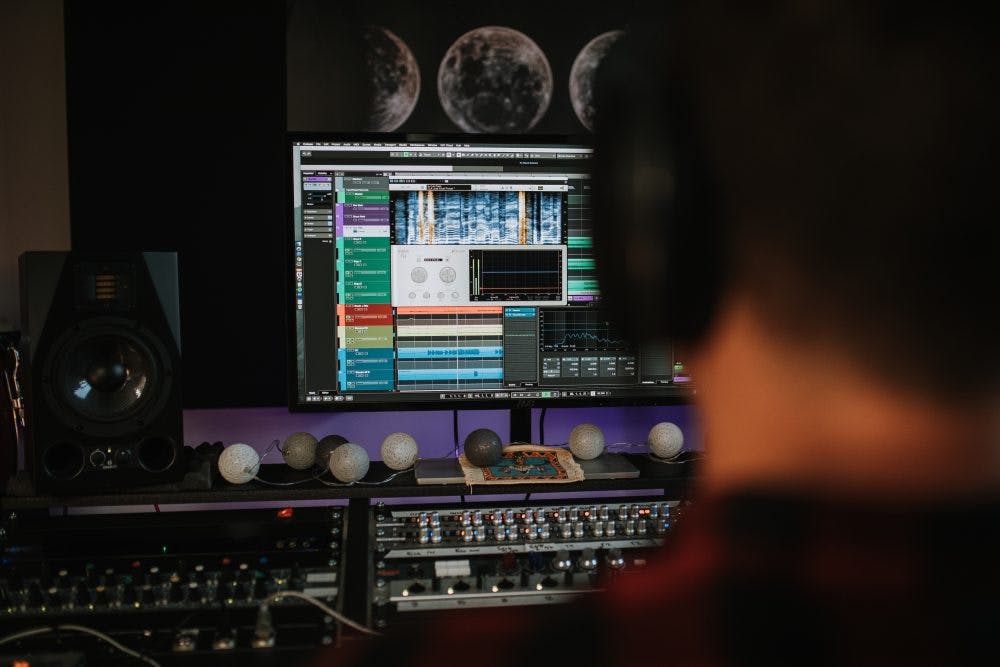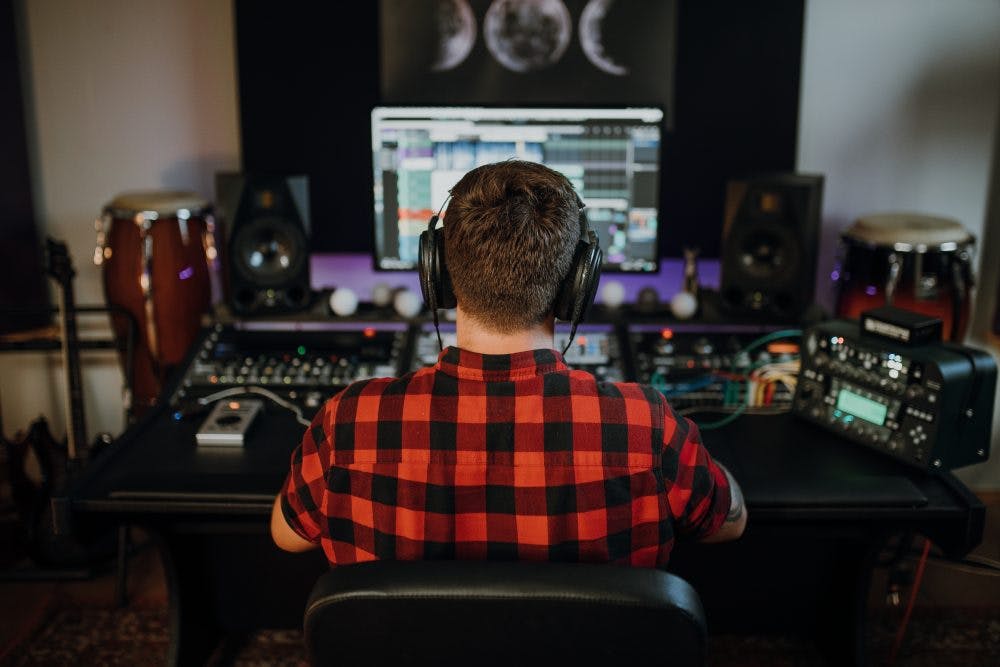Headphones versus loudspeakers: which is better for monitoring? At some point most beginners ponder this question—though to be fair, so do most experienced engineers. Glenn Schick, the mastering engineer whose credits include J Cole, Justin Bieber, Jason Isbell, Elton John, and many others, recently made the switch to mastering exclusively on headphones. Plenty of other engineers have gone the opposite route, opting for high-end monitors as they grow out of their home studios and move to dedicated studio spaces.
As to the core question of which is better, headphones or loudspeakers, the honest answer is, unfortunately, “It depends.” Both headphones and monitor speakers exhibit certain beneficial qualities and certain limitations. I’m here to help you identify the strengths and limitations of each option, so read on to determine which may be best for you.
Loudspeaker Strengths
Speakers produce sound waves by moving air molecules throughout the physical space of your room and therefore communicate not just the sound of music, but also the physical feeling of the music. Hearing a kick drum solely with your ears is one sensation, versus experiencing the impact of the kick in your chest and the vibration of your pant legs. Feeling the physical power and how the low-end “fills the room” can help you gauge how your mix will translate to clubs, cars, and home hi-fi systems.
Many people find it easier to achieve proper musical balances on loudspeakers rather than on headphones. For instance, when you set the level of background vocals in a mix using headphones, the balance might not translate well to your car, or even to your reference studio monitors. This is due, in part, to the natural interaction between speakers and the physical listening space.
As we mentioned earlier, speakers push sound waves around the room, which is different than the way headphones direct sound right into your ears. Sound waves from speakers are reflected and absorbed by objects in the room and undergo shifts in timing and phase, providing our brain with directional and level information that feels natural and organic. Each of our ears hears the speaker that is pointed towards, plus the sound of the room.
Headphones, on the other hand, isolate the ears so that each ear only hears the output of one speaker and, therefore, only one side of the stereo image. Put another way, when listening to stereo speakers, your left ear hears a bit of the right speaker, but with different reflections, timing, and phase from what your right ear hears from the right speaker. Headphones do not provide any right channel information to the left ear, or vice-versa. This acoustic effect of each ear hearing a bit of the opposite speaker’s information is referred to as “crossfeed.”

Speaker Limitations
The most obvious downside to using monitors is a practical issue: loudspeakers are loud—you need to drive them somewhere around 80dB SPL for a balanced representation of all frequencies (remember the Fletcher-Munson curves?). If you live in a thin-walled city apartment, you may not be able to run your speakers suitably loud without annoying the neighbors. Furthermore, the in-room frequency response of your speakers is affected by the acoustics of your room. The shape of the room, the construction materials, the placement of your speakers/furniture, and the degree of room treatments—these all have an effect on how your speakers sound. Headphones, on the other hand, are immune to the room’s effects.
A speaker’s quality and accuracy, to some degree, relate to its cost. While excellent-sounding professional headphones can cost under a few hundred dollars, most speakers under $1000/pair won’t produce important low frequencies very well. Many inexpensive speakers purport to reproduce this range, but independent analysis reveals they do not—and furthermore what they do give you below 60 or 70Hz may not be accurate or clean enough for mixing or mastering. While room-correction software like SoundID Reference can help flatten a speaker systems’ frequency response, it can’t make up for a small speaker’s inability to produce low frequencies, and it can’t fix the distortion and phase issues that plague inexpensive monitor systems.
The Strengths of ‘Phones
For this discussion of headphones, we will be referring to professional headphones and not earbuds or consumer headphones. Cost may not be the sole indicator of professional versus consumer quality, as many consumer headphones are expensive fashion accessories. Pro headphones should provide excellent sonic qualities and typically will not include features like Bluetooth or noise-canceling circuitry. Pro headphones may include features like replaceable earpads, interchangeable cables, and adapters for both ¼” and 3.5mm connections.
Let’s highlight an important advantage of headphones straight away: you can listen to them day or night, at a reasonable volume, without bothering the neighbors. Closed-back phones are virtually silent to people around you, while open-backed headphones shouldn’t disturb anyone more than a few feet away from you.
Headphones excel at certain monitoring jobs. Mastering engineers often put on their headphones to QC (quality control) check their final masters because phones often reveal details in a master—clicks, pops, and other incongruities–that may not be obvious on speakers. The clarity that comes from headphones helps put a spotlight or microscope on tiny elements of the mix. Frequent users of forensic tools like iZotope RX find that headphones are well suited for locating and repairing clicks, pops, and other low-level distortions.
Headphones provide benefits to engineers working in less-than-optimal rooms. If your room has acoustic issues, using headphones can mitigate those problems by removing the room’s influence on audio perception. Headphones can also block out distractions like the hum of household appliances, the din of traffic, or even a neighbor watching a soccer match. When choosing a pair of headphones, consider that open-back headphones might not be suitable for working in a noisy environment like a coffee shop, while closed-back headphones may provide enough isolation that you can spend an afternoon working productively at the beach.
This brings us to mobile considerations: I often travel from studio to studio, and I have to produce consistent results in unfamiliar surroundings, on unfamiliar speakers. I bring my own set of cans so I can work confidently on a familiar and relatively consistent monitoring system.
The Limitations of ‘Phones
Notice I wrote “relatively consistent” above; there’s some room for error in that qualifying adjective. If I take my headphones from a pro studio that uses a high-power headphone amp like the Little Labs Monotor to a home studio with an underpowered headphone amp or interface’s headphone output, I’ll likely notice that my headphones sound different on each system.
A couple of issues are at play here. Since headphones can be extremely revealing, they often highlight differences in frequency response, noise floor, and overall accuracy of the monitoring chain. Also, each model of headphones has a different power and impedance specifications, and each headphone may react to a specific headphone amp or interface in a profoundly different way. Most headphones will work fine with any decent audio interface, while some only perform their best when powered by a dedicated headphone amplifier. My Audio-Technica ATH-M50xs phones, for example, sound great with most headphone amplifiers, while my Sennheiser HD 650s sound different when powered by different interfaces or headphone amps. If you move from studio to studio as I do, you may want to invest in a reliable pair of phones, and also a trustworthy headphone amp, like the affordable Schiit Magni 3 or JDS Labs ATOM or the more feature-rich, but costly Little Labs Monotor or Rupert Neve RNHP.

Remember when we mentioned that headphones play independently into each ear? This means you lose the natural crossfeed effects, affecting your perception of and mix decisions regarding left-to-right panning (width), as well as front-to-back depth. As a result panning, ambience and even equalization and balances that sound proper on your headphones may sound less cohesive on loudspeakers. Panning a vocal to the center on a pair of speakers puts the vocal in front of you, in the phantom center. On headphones, the vocal sits between your ears. Neither is right or wrong, but you may have to become accustomed to the translation between ‘phones and speakers.
Indeed, a headphones-only mix could lead to questionable decisions during the mixing process. When I create a mix using my Audio-Technica ATH-m50xs, I find my low-end levels often have to be tweaked later. Similarly, if I attempt a mix using only my HD 650s, I wind up boosting the high frequencies more than necessary. Reference 4 will flatten the frequency response of most headphones while plugins like CanOpener (and even some headphone amps) provide crossfeed that mimics, on headphones, the spatial presentation of speakers. Fortunately, the room acoustics do not affect your headphones, so it is easier to correct headphone frequency anomalies than to correct speakers in a room. Reference 4 provides built-in correction curves for hundreds of headphone models, while every speaker setup requires the creation of a custom correction curve.
Choosing headphones is inherently personal, perhaps even more so than choosing monitors. When planar magnetic headphones (like the Audeze LCD-X) became the rage, I bought a pair and found myself disappointed with the experience. I went back and forth with the manufacturer a few times, sending them in for diagnostics and discussing headphone amps and such. Finally, they shrugged and said, “It’s probably the shape of your head—your ear geometry.” Each pair of headphones will provide a different experience due to their size, shape, construction materials, and design philosophy. Ultimately we must consider the physical limitations of headphones. Phones just don’t push air as speakers do, so you will not feel that guttural, vibrational punch that speakers provide—a punch that aids in musical translation.
Conclusion
Since we can’t clearly answer which is better, what’s one to do? Use both! A combination of headphones and speakers could be your friend. Throughout your career, you’ll find a process that works for you—a gameplay loop, if you will. You may build your mix on speakers, check for forensic issues on cans, and continue switching between the two while mixing. Perhaps you’ll work differently, setting up the balances in cans for clarity’s sake and then finishing the mix on your monitors. Since COVID began and I’m working more at home, I’ve successfully reversed my usual 90% speakers, 10% cans usage to about 80% cans, 20% speakers.
It may take some trial and error, but if you devise a routine that utilizes the strengths of both monitor types, you’re less prone to the weaknesses of either. Remember that Sonarworks correction software can improve both your headphones and loudspeakers––whichever platform you choose.
Check out these articles to help you get the most out of your ‘phones and your monitors:




